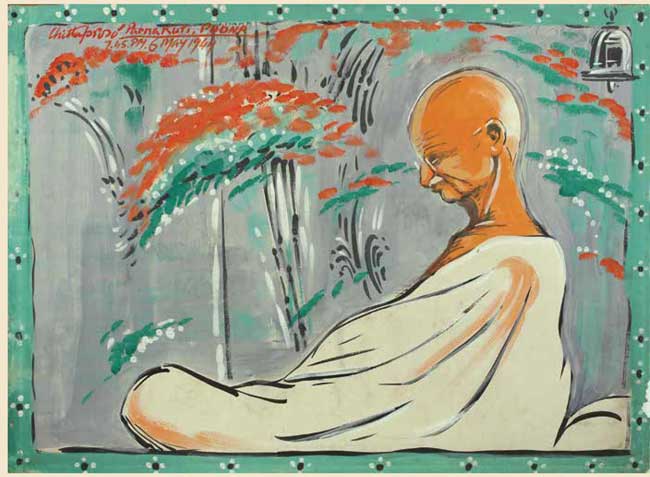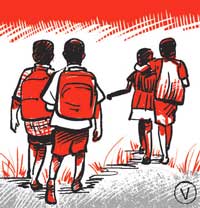According to the Unesco Atlas of the World’s Languages in Danger 2009, India has around 196 endangered languages. Prof. Omkar Koul, former director of the Central Institute of Indian Languages, observes:
No one knew how many minor and tribal languages existed in India at present. The Indian Constitution protects the right of children to learn through their mother tongue. – The Telegraph, March 3 , 2011
Prof. Ganesh Devy (Chair, People’s Linguistic Survey of India) believes that the problems faced by speakers of indigenous languages should be solved by other means than legislation:
Adivasi languages in a state have always strayed into the larger language of that state. The contact with Persian, Arabic, which was active at one time too has weakened now. The market needs have brought the bhashas closer to English, and there’s too much of intimacy with English. So languages keep changing all the time. And so long as human beings are there, interacting with the phenomenal world, languages will be there. They need greater attention, but it cannot happen through legislation. Languages should not be legislated. When there was no legislation, languages were safer. With legislation, they start going down. That is the experience all over the world. In Russia, Spain and China it has been so, in India it has been so. – A View of Higher Education in India
Find out more: Endangered languages, Cultural invisibility – India’s 600 potentially endangered languages and the Linguistic Survey of India (official website) >>
Award-winning publisher Ruby Hembrom, in her column for the New Indian Express, seeks to strike a balance between the needs of the modern world – like education and a fair command of English – and Adivasis’ affirmation of their cultural roots:
Being Adivasi doesn’t automatically qualify one to avail the quota. […] The disparity in standards of education in rural or urban areas is so large that we cannot make the cut, cannot crack entrance exams or interviews despite the reservation provisions. These gaps translate to opportunity gaps. How can someone qualify from vacuum?
Source: “Penalised for the State’s mistakes” in The New Indian Express, 11th August 2016.
(Ruby Hembrom is the founder and director of adivaani, an archiving and publishing outfit of and by Adivasis)
“We shall first have to give up this hubris of considering tribes backward. Every tribe has a rich and living cultural tradition and we must respect them.” – Vice President M. Venkaiah Naidu on the constitutional obligation to respect the cultural traditions of India’s tribal communities

Gandhian social movement | Constitution | Adverse inclusion >>
“Air is free to all but if it is polluted it harms our health… Next comes water… From now on we must take up the effort to secure water. Councillors are servants of the people and we have a right to question them.” – Mohandas K. Gandhi, Ahmedabad address on 1 January 1918; quoted by his grandson, Gopalkrishna Gandhi, in “On another New Year’s Day: Mahatma Gandhi’s ‘khorak’ a 100 years ago” (The Hindu, 1 January 2018)
“The world has enough for everyone’s need but not for anyone’s greed.” – Mahatma Gandhi quoted by Medha Patkar and Baba Amte (Narmada Bachao Andolan)
“The Big-brother attitude of educators must end. The approach to tribal education has to be a two-way transaction of give and take, based on an informed appreciation of traditional tribal values and wisdom.” – Uma Ram (Professor & Head Department of English, Kakatiya PG College, Chhattisgarh) in Issues in Tribal Education in Bastar, Chhattisgarh (Folklore Foundation, Lokaratna, Volume IV 2011)
Residential, Ashram and Factory schools

- Ekalavya* Residential School Scheme (EMR): a network of boarding schools where tribal children are to be educated in accordance with rules and syllabi provided by the government; such schools are being designated as “Eklavya Model Residential School (EMR)” with the objective of empowering students “to be change agent, beginning in their school, in their homes, in their village and finally in a large context.” – Government Guidelines 2010 | Backup >>
- Residential School and Ashram School
In some regions there are similar “Residential Schools” and “Ashram Schools” for tribal children, as in Tripura where they are managed by a society called “Tripura Tribal Welfare Residential Educational Institutions Society (TTWREIS)” – Tribal Welfare Department, Government of Tripura - Factory schools “exist to turn tribal and indigenous children – who have their own language and culture – into compliant workers-of-the-future. The world’s largest Factory School stated that it turns ‘Tax consumers into tax payers, liabilities into assets’.” – survivalinternational.org/factoryschools | Learn more >>
Up-to-date information about these and related issues: Safe custom search engine >>
* Ekalavya (Eklavya, Eklabya): the name of a legendary archer prodigy “who, being a Nishada [Sanskrit Niṣāda, “tribal, hunter, mountaineer, degraded person, outcast”], had to give his thumb as a fee to the brahmin guru thus terminating his skill as an archer.” – Romila Thapar (“The epic of the Bharatas”) | Read the full paper here | Backup download link (pdf) >>
Note: “Forcibly transferring children of the group to another group” amounts to genocide, which the United Nations Office on Genocide Prevention defines as “acts committed with intent to destroy, in whole or in part, a national, ethnical, racial or religious group” (Article II, d & e)
Learn more about Childrens rights: UNICEF India | Ekalavya (Eklavya, Eklabya), EMR & Factory schools | Rights of Indigenous Peoples >>
Tip: click on any red marker for details on endangered languages in a particular region of India.
Please note: the facts and figures cited (via hyperlinks) links call for updates and fact checking >>
Cultural invisibility – India’s 600 potentially endangered languages | Linguistic Survey of India (official website) >>
- Continue the guided tour – Part 9 >>
- Start the guided tour (Part 1)